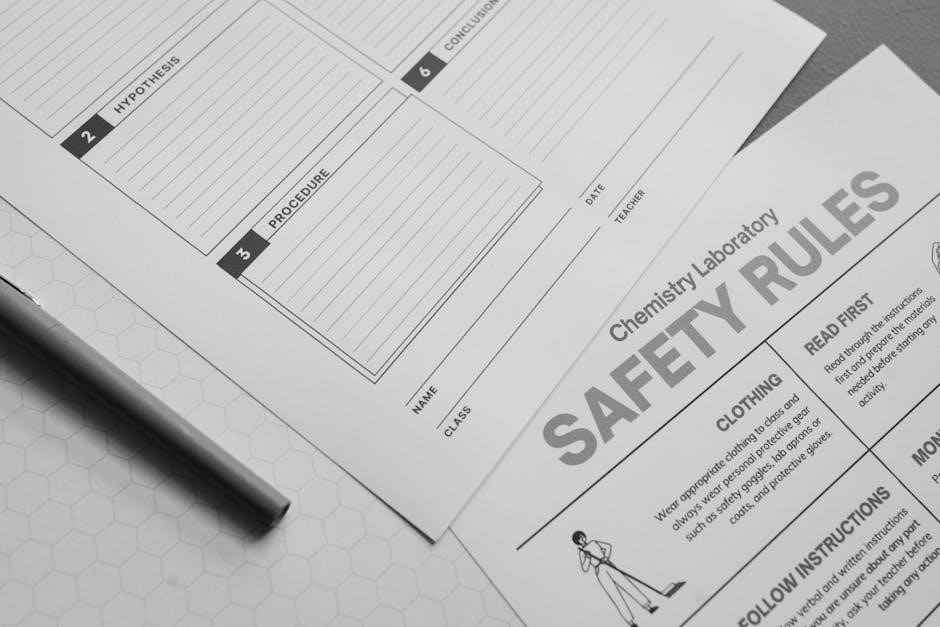Chemistry Study Guide PDF: An Overview
A chemistry study guide in PDF format serves as a valuable resource. It assists students by offering a structured approach to learning and understanding complex chemical principles. These guides often include key concepts, examples, and practice problems.
Chemistry, the study of matter and its interactions, forms the foundation for understanding the world around us. From the smallest atoms to the most complex molecules, chemistry explains the composition, structure, properties, and reactions of substances. Its importance spans across numerous fields, including medicine, agriculture, and environmental science.
A solid grasp of chemical principles is essential for advancements in drug development, materials science, and sustainable energy solutions. Chemistry allows us to analyze and manipulate matter, leading to innovations that improve our lives. Understanding chemical reactions is key to addressing environmental challenges, such as pollution control and climate change.
Therefore, studying chemistry provides a powerful toolkit for problem-solving and critical thinking, enabling individuals to contribute meaningfully to scientific and technological progress. The study guides provide direction for students.
Core Concepts Covered in Chemistry Study Guides
Chemistry study guides typically cover a range of core concepts essential for a solid foundation. These include the structure of atoms, the periodic table, and chemical bonding. Understanding states of matter – solid, liquid, gas, and plasma – is also crucial, as well as the transitions between them.
Chemical reactions, stoichiometry, and balancing equations are fundamental. Acids, bases, and pH are also key topics, along with thermochemistry, which explores energy changes in chemical reactions. Solutions, including concentration and colligative properties, are often included. Moreover, study guides may delve into kinetics, exploring reaction rates and mechanisms, and equilibrium, describing reversible reactions.
Electrochemistry, dealing with oxidation-reduction reactions and electrochemical cells, is another significant area. Organic chemistry concepts, such as functional groups and basic reactions, may also be introduced. These core concepts, thoroughly explained in chemistry study guides, provide a comprehensive overview for students.

Key Topics in General Chemistry
General chemistry encompasses fundamental principles. Key topics include atomic structure, chemical bonding, stoichiometry, and states of matter. Thermodynamics, kinetics, equilibrium, acids, and bases are also crucial areas of study for students.
States of Matter, Atoms, and the Periodic Table
Chemistry begins with understanding the three states of matter: solid, liquid, and gas. Each state exhibits unique properties. The arrangement and behavior of atoms define these differences. Atoms, the fundamental building blocks, comprise protons, neutrons, and electrons.
The periodic table organizes elements based on their atomic structure and properties. Elements in the same group (vertical column) share similar chemical behaviors. Understanding trends in electronegativity, ionization energy, and atomic size is crucial. The table provides a framework for predicting reactivity and bonding patterns. Electron configuration dictates an atom’s chemical behavior.
Quantum mechanics explains the arrangement of electrons in atoms. This knowledge is essential for understanding chemical bonding and molecular properties. States of matter, atomic structure, and the periodic table lay the foundation for grasping more advanced chemistry topics.
Chemical Bonds, Equations, and Stoichiometry
Chemical bonds hold atoms together to form molecules. Ionic bonds involve electron transfer, while covalent bonds involve electron sharing. Understanding electronegativity helps predict bond polarity. Chemical equations represent chemical reactions. Balancing equations ensures mass conservation, a fundamental principle.
Stoichiometry deals with the quantitative relationships in chemical reactions. The mole concept links mass to the number of atoms or molecules. Molar mass converts between mass and moles. Stoichiometric calculations determine reactant and product quantities. Limiting reactants dictate the maximum product yield. Percent yield compares actual yield to theoretical yield.
Mastering these concepts is essential for predicting reaction outcomes. Proper balancing and stoichiometric calculations are vital for accurate experimental results. Chemical bonds, equations, and stoichiometry form the backbone of quantitative chemistry. Without these principles, it is difficult to predict the outcome of any chemical process.
Acids, Bases, and Thermochemistry
Acids donate protons, while bases accept protons. Strong acids and bases completely dissociate in water. pH measures the acidity or basicity of a solution. Buffers resist changes in pH upon addition of acid or base. Titration is a technique to determine the concentration of an acid or base. Understanding acid-base chemistry is crucial in many applications.
Thermochemistry studies heat changes during chemical reactions. Exothermic reactions release heat, while endothermic reactions absorb heat. Enthalpy change (ΔH) quantifies heat flow at constant pressure. Hess’s Law calculates enthalpy changes for multi-step reactions. Standard enthalpies of formation are used to calculate reaction enthalpies.
Calorimetry measures heat flow experimentally. These principles govern energy transformations in chemical systems. Mastering these concepts allows prediction and manipulation of chemical reactions. The interplay between acids, bases, and thermochemistry shapes many chemical processes. Without these concepts, understanding chemical reactions is difficult to understand.

Organic Chemistry Study Guide Focus
Organic chemistry study guides focus on carbon-containing compounds. They will also focus on functional groups, reactions, mechanisms, and spectroscopic techniques. These help in identifying and understanding organic molecules and their behavior during chemical reactions.
Functional Groups and Reactions
Functional groups are specific arrangements of atoms within molecules that dictate their reactivity and chemical properties. Understanding these groups is crucial in organic chemistry as they determine how molecules interact. Study guides often provide detailed overviews of common functional groups like alcohols, ketones, amines, and carboxylic acids.
A key aspect of studying organic chemistry involves mastering the reactions associated with each functional group. These reactions include additions, substitutions, eliminations, and rearrangements. Study guides typically outline reaction mechanisms, explaining step-by-step how reactants transform into products. Learning these mechanisms helps in predicting reaction outcomes and designing synthetic pathways.
Furthermore, study guides emphasize the importance of understanding the conditions under which reactions occur. Factors such as temperature, solvents, and catalysts can significantly impact reaction rates and selectivity. By focusing on functional groups and their reactions, students can develop a solid foundation in organic chemistry, enabling them to tackle complex problems and understand real-world applications.
Spectroscopy (IR, Mass Spec, NMR)
Spectroscopy is an essential analytical technique in chemistry, particularly in organic chemistry, used to determine the structure and properties of molecules. Infrared (IR) spectroscopy identifies functional groups based on their vibrational frequencies. Mass spectrometry (Mass Spec) determines the molecular weight and fragmentation patterns, aiding in identifying unknown compounds.
Nuclear Magnetic Resonance (NMR) spectroscopy provides detailed information about the carbon-hydrogen framework of a molecule. Study guides often dedicate sections to interpreting spectra from these techniques. They explain how to identify key peaks and patterns, linking spectral data to structural features. Practice problems involving spectral interpretation are crucial for mastering these techniques.
Study guides also highlight the complementary nature of these spectroscopic methods. Combining data from IR, Mass Spec, and NMR allows for a comprehensive structural elucidation of organic molecules. Understanding the principles behind each technique and practicing spectral analysis are vital skills for any chemistry student.

Effective Study Strategies for Chemistry
Effective study strategies in chemistry involve creating a structured study plan and managing time efficiently. Consistent practice with problems, reviewing key concepts, and active learning methods are vital for success.
Creating a Study Plan and Time Management
Creating a well-structured study plan is crucial for success in chemistry. Begin by assessing the time available before exams and allocating specific periods for each topic. Break down the syllabus into manageable sections, focusing on core concepts and areas needing improvement.
Effective time management is equally important. Schedule dedicated study sessions, minimizing distractions and utilizing techniques like the Pomodoro method. Regular, consistent study habits are more effective than last-minute cramming.
Prioritize topics based on difficulty and exam weighting. Incorporate review sessions to reinforce learning and address any gaps in understanding. Flexibility is key; adapt the plan as needed to accommodate unexpected challenges or changes in priorities.
Utilize resources like study guides and practice tests to gauge progress and identify areas requiring further attention. Balance studying with adequate rest and breaks to maintain focus and prevent burnout, ensuring a sustainable and productive learning journey.
Practice Problems and Review Questions
Engaging with practice problems and review questions is essential for mastering chemistry. These exercises reinforce theoretical knowledge and improve problem-solving skills. Begin by working through examples provided in study guides and textbooks, focusing on understanding the underlying principles.
Subsequently, tackle a variety of practice problems, gradually increasing in difficulty. Pay close attention to the steps involved in solving each problem, and identify any recurring patterns or strategies.
Review questions, including multiple-choice and short-answer formats, help assess comprehension of key concepts. Use these questions to identify areas where further study is needed.
Regularly review previously covered material to reinforce learning and prevent forgetting. Create flashcards or use online tools to quiz yourself on important definitions, formulas, and reactions.
Collaborate with classmates to discuss challenging problems and review questions. This collaborative approach can provide different perspectives and enhance understanding.

Utilizing Chemistry Study Guides for Exam Preparation
Chemistry study guides are invaluable tools for exam preparation. Begin by identifying the specific topics covered on the exam and then prioritize your study efforts accordingly. Focus on the areas where you feel least confident, using the study guide to reinforce your understanding.
Work through practice problems and review questions provided in the study guide. Simulate exam conditions by timing yourself and avoiding distractions. Analyze your performance to identify areas where you need further review.
Create flashcards or use online tools to memorize important definitions, formulas, and reactions. Regularly quiz yourself to reinforce your knowledge. Review past exams or practice tests to familiarize yourself with the exam format and question types.
Collaborate with classmates to review material and discuss challenging concepts. Get enough sleep and eat a healthy meal before the exam. Stay calm and focused during the exam, and manage your time effectively.
